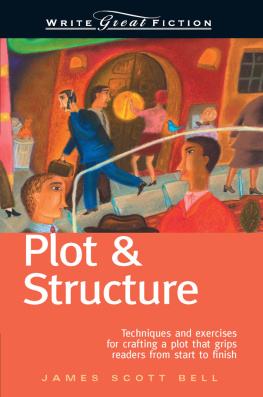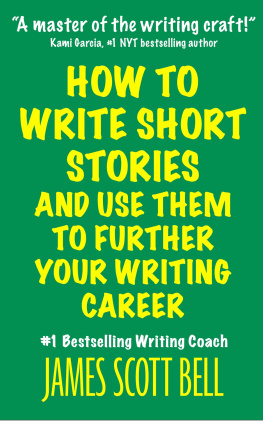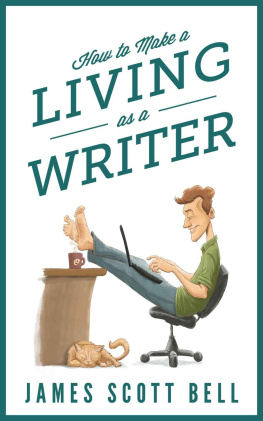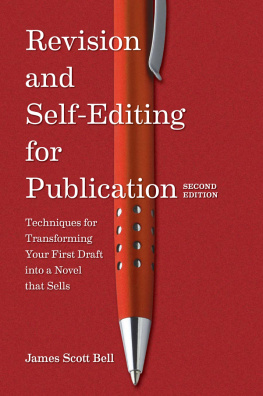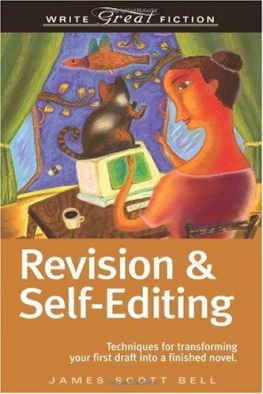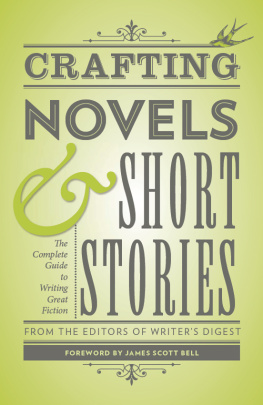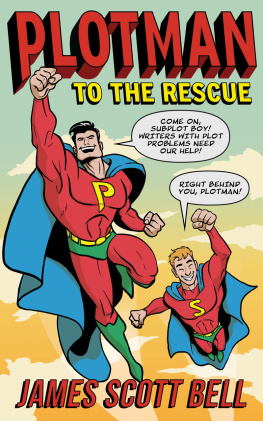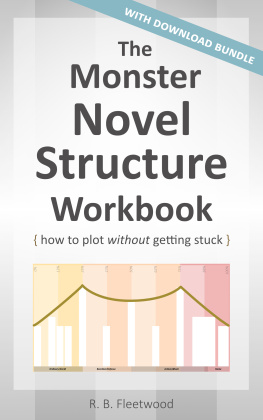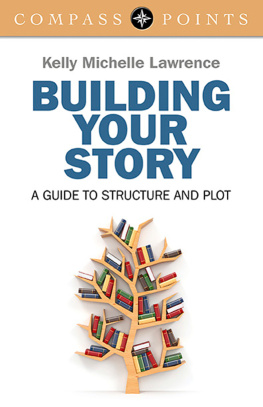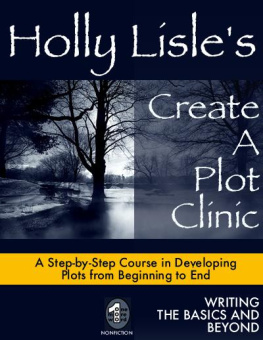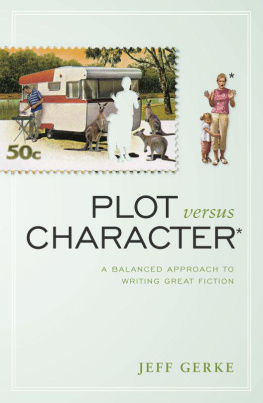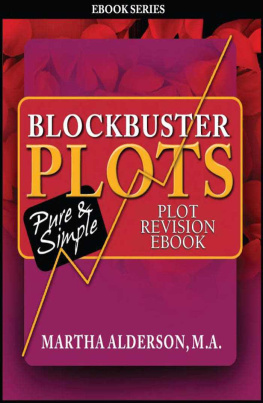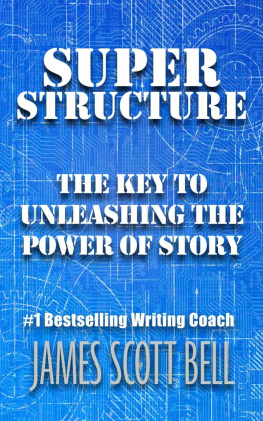Write Great Fiction
Plot and Structure
Techniques and exercises for crafting a plot that grips readers from start to finish
James Scott Bell
Cincinnati, Ohio
www.writersdigest.com
Write Great Fiction: Plot & Structure 2004 by James Scott Bell. Manufactured in the United States of America. All rights reserved. No part of this book may be reproduced in any form or by any electronic or mechanical means including information storage and retrieval systems without permission in writing from the publisher, except by a reviewer, who may quote brief passages in a review. Published by Writers Digest Books, an imprint of F+W Publications, Inc., 4700 East Galbraith Road, Cincinnati, OH 45236. (800) 289-0963. First edition.
Visit our Web site at www.writersdigest.com for information on more resources for writers.
To receive a free weekly e-mail newsletter delivering tips and updates about writing and about Writers Digest products, register directly at our Web site at http://newsletters.fwpublications.com.
Library of Congress Cataloging-in-Publication Data
Bell, James Scott.
Write great fiction: plot & structure: techniques and exercises for crafting a plot that grips readers from start to finish / by James Scott Bell.
ISBN-13: 978-1-58297-294-7
ISBN-10: 1-58297-294-X
eISBN-13: 978-1-58297-684-6 (EPUB)
1. Plots (drama, novel, etc.). 2. Fiction Authorship. I. Title
PN3378.B45 2004
2004053032

Edited by Kelly Nickell
Print version designed by Stanard Design Partners
Cover by Nick Gliebe/Design Matters
Cover illustration Getty Images
Production coordinated by Robin Richie and Logan Cummins
About the Author
James Scott Bell is the best-selling author of Breach of Promise, Deadlock, A Greater Glory, and several other thrillers. He is a winner of the Christy Award for Excellence in inspirational fiction, and is currently a fiction columnist for Writers Digest magazine. A former trial lawyer, Jim now writes and speaks full time. His Web site is www.jamesscottbell.com.
Dedication
To my wife, Cindy, who is my inspiration, editor-in-chief, and best friend. Thanks for helping make my dreams come true.
And to my children, Nate and Allegra, who make me proud.
Acknowledgments
I must thank all of the generous and thoughtful writers who have given us, in books and articles, their collective wisdom on the art of fiction. When I finally figured out that the craft was something that could be taught, I dove into a massive reading program and found a body of advice that gave me hope I could someday learn to write.
While I cant possibly thank all of those who have helped me, I want to give credit to at least the following books that I continue to turn to:
Bickham, Jack, Writing and Selling Your Novel
Bishop, Leonard, Dare to be a Great Writer
Block, Lawrence, Writing the Novel
Browne, Renni & King, Dave, Self-Editing for Fiction Writers
Bradbury, Ray, Zen in the Art of Writing
Cleaver, Jerry, Immediate Fiction
Conrad, Barnaby, Complete Guide to Writing Fiction
Egri, Lajos, The Art of Creative Writing
Frey, James N., How to Write a Damn Good Novel I & II
Hall, Oakley, The Art & Craft of Novel Writing
Kernen, Robert, Building Better Plots
King, Stephen, On Writing
Koontz, Dean, How to Write Best-Selling Fiction
Maass, Donald, Writing the Breakout Novel
Morrell, David, Lessons From a Lifetime of Writing
Stein, Sol, Stein on Writing
Swain, Dwight, Techniques of the Selling Writer
Whitney, Phyllis, Guide to Fiction Writing
Thanks also to some writer friends who looked at early portions of this work: Angela Hunt, Randall Ingermanson, and Janelle Schneider. And special thanks to my editor on this project, Kelly Nickell, and to all the folks I work with at Writers Digest magazine, who know that writing can be taught and prove it every day.
Introduction
Putting the Big Lie to Sleep
I wasted ten years of prime writing life because of the Big Lie.
In my twenties, I gave up the dream of becoming a writer because I had been told that writing could not be taught. Writers are born, people said. You either have what it takes or you dont, and if you dont youll never get it.
My first writing efforts didnt have it. I thought I was doomed. Outside of my high school English teacher, Mrs. Marjorie Bruce, I didnt get any encouragement at all.
In college, I took a writing course taught by Raymond Carver. I looked at the stuff he wrote; I looked at my stuff.
It wasnt the same.
Because writing cant be taught.
I started to believe it. I figured I didnt have it and never would.
So I did other stuff. Like go to law school. Like join a law firm. Like give up my dream.
But the itch to write would not go away.
At age thirty-four, I read an interview with a lawyer whod had a novel published. And what he said hit me in my lengthy briefs. He said hed had an accident and was almost killed. In the hospital, given a second chance at life, he decided the one thing he wanted was to be a writer. And he would write and write, even if he never got published because that was what he wanted.
Well, I wanted it, too.
But the Big Lie was still there, hovering around my brain, mocking me.
Especially when I began to study the craft of writing.
I went out and bought my first book on fiction writing. It was Lawrence Blocks Writing the Novel. I also bought Syd Fields book on screenwriting because anyone living in Los Angeles who has opposable thumbs is required to write a screenplay.
And I discovered the most incredible thing. The Big Lie was a lie. A person could learn how to write because I was learning.
HOW I BECAME A HAPPY PLOTTER
While in the throes of the Big Lie, the most frustrating thing to me was Plot. Because what I wrote didnt have it.
I would read short stories and novels, and wonder how the writers did it. How did they get all this great story material? The Big Lie said they had it in their heads, naturally, and it just flowed out on the page as they went along.
I tried it. I tried to let plot flow. But what came out on the page was dreadful. No plot! No story! Zip!
But when I began to learn about the craft, I saw that plotting had elements I could learn. And I found out about structure: when plot elements were put in a certain order, a stronger story resulted.
I can still remember the day it came together for me. It was an epiphany. All of a sudden, something clicked in my head. The pieces started to fit. The Jell-O hardened.
About a year later, I had a screenplay optioned. Then another.
Then I wrote a novel. It was published.
Then I got a five-book fiction contract. I wrote those books, and they were published, too.
Suddenly, I took a deep breath and looked behind me. Somehow, some way, I had learned how to write after all.

